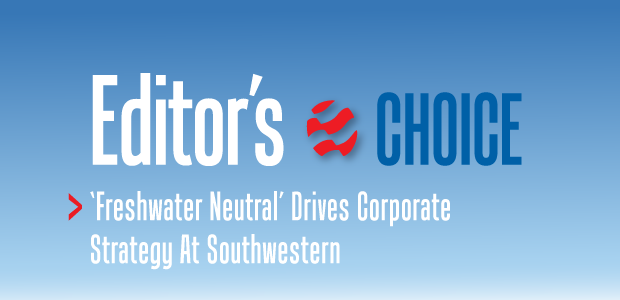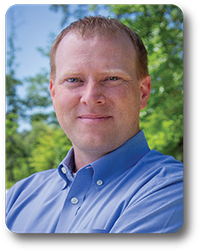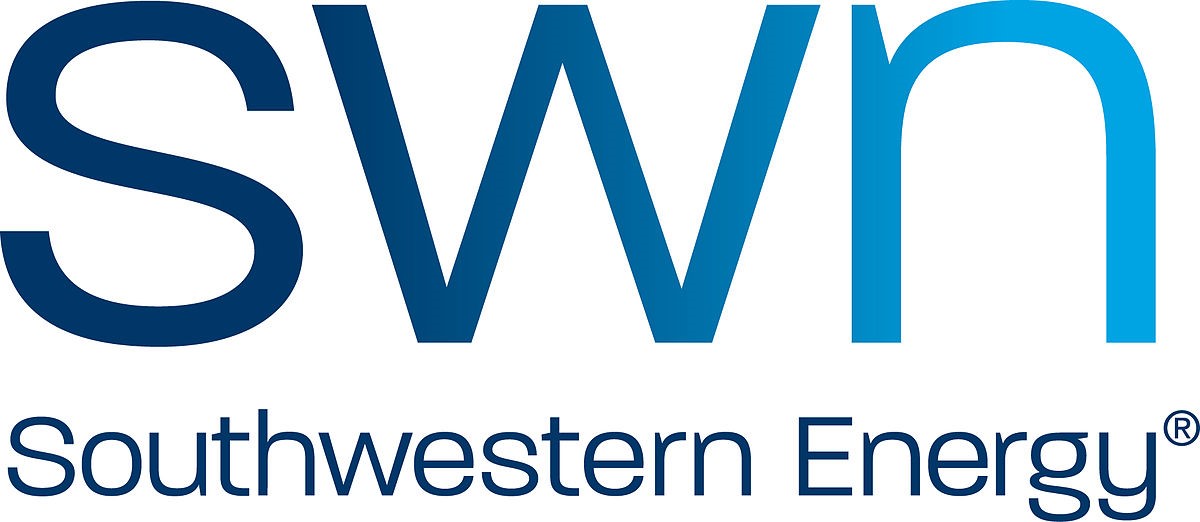
‘Freshwater Neutral’ Drives Corporate Strategy At Southwestern
Editor’s Note: Environmental stewardship is serious business for the U.S. upstream industry. In producing basins across the country, oil and gas companies are proactively going well beyond federal and state regulatory requirements to protect the natural environment in all of their operational activities, including hydraulic fracturing. Pumping a multistage frac treatment in a typical horizontal well in a tight oil or shale gas play requires millions of gallons of water, and much of the volume ultimately is returned back to surface during production.
There is no better example of going above and beyond than Southwestern Energy Company when it comes to managing and disclosing the water and chemicals used in well fracturing, according to a report released earlier this year by a shareholder advocacy group and investment advisory firm. The report, “Disclosing the Facts 2019: Transparency and Risk in Water and Chemicals Management for Hydraulic Fracturing Operations,” graded 30 North American oil and gas companies and Southwestern Energy came out at the top of the list.
Among Southwestern Energy’s internal environmental stewardship initiatives is its Energy Conserving Water (ECH2O®) program, which provides a comprehensive approach to water management, including making its operations “freshwater neutral.” The company launched ECH2O seven years ago, and later achieved its freshwater neutral goal.
To get an update on Southwestern Energy’s water and fracturing fluid management programs, AOGR presented a series of questions to Rowlan Greaves, senior staff water engineer, technology, at Southwestern Energy.
Questions are in italics, followed by his responses.
Q: One of Southwestern Energy’s primary objectives in implementing its ECH2O initiative was achieving freshwater neutrality in its operations. It achieved that goal in 2016 and has maintained it since. Describe the freshwater neutral strategy. How does this approach support Southwestern’s completion activities and align its field operations with its broader environmental and conservation goals?
GREAVES: We seek to be a responsible steward of the environment wherever we operate. SWN topped 30 North American oil and gas producers for transparency in water and chemical management practices in a 2019 investor report (www.disclosingthefacts.org). The company attained its goal to be freshwater neutral in 2016 and has maintained this status every year since.
Freshwater neutral means that for every gallon of freshwater it uses in its operations, SWN offsets an equivalent amount or more through water conservation projects. Being freshwater neutral is a testament to the company’s core value of environmental stewardship.
With respect to operational activity, the freshwater neutral program begins with our own operations. The company manages its own water usage, using less freshwater and sourcing as much water as possible from recycled and other sources. We recycle produced water safely and efficiently within all of our completion activities.
Looking at SWN’s clean water and conservation initiatives, since 2014, SWN has completed 10 water conservation projects in Arkansas, Pennsylvania and West Virginia. The total beneficial freshwater volume from these projects resulted in more than 9 billion gallons of freshwater returned or restored to environments supporting our operations. Recently, we partnered with the West Virginia Department of Environmental Protection in an innovative, multiyear investment project to restore the Muddy Creek watershed, which covers 150 square miles and includes dozens of tributary surface and underground streams. SWN water projects have included stream channels and habitat restoration; riparian and floodplain improvements and revegetation; and wetland creation, irrigation optimization and aquatic habitat revitalization. Our commitment to environmental water solutions has restored and rejuvenated water ecosystems, adding options for recreation, wildlife and economic development.
Q: Zooming back out, describe the overall ECH2O initiative. How does this support continued oil and gas operations while reducing freshwater needs? What issues arise with using alternative water sources? How can operators maximize the economics associated with alternative and recycled water sources?
GREAVES: As noted, the ECH2O program is all about freshwater neutrality. It was implemented to build on SWN’s commitment to replenish an equivalent amount of water, through conservation and innovation, for every gallon it uses in its operations. ECH2O focuses on four areas: water conservation, usage reduction, protection and innovation. Each of these areas, in turn, supports the company’s mission to develop, produce and supply responsible natural gas, natural gas liquids and condensate for North America and the world.
One area of innovation in ECH2O is the search and use of alternative water sources. These are typically undesirable or brackish water types from other companies or communities. The efficient use of alternative water sources can be challenging, with complications around supply logistics, potential expenses for treatment and conditioning, variable quality, quantity and all-in economics.
Some advantages to being freshwater neutral include gains from recycling produced and/or brackish water; firm leverage against public dissent on regional water usage; and positive differentiation and goodwill afforded by stakeholders and investors.
Additional advantages to becoming freshwater neutral also may include:
- Reduced dependence on freshwater resources;
- Fewer volumes to dispose of, and fewer concerns about potential seismicity;
- Counteraction to criticism about freshwater use in arid and drought-prone areas;
- Water conservation projects to help communities anxious to improve natural water resources;
- Stronger community ties through partnerships with local leaders, academia, nongovernmental organizations and others;
- Positive, responsible differentiation of products contracted to midstream companies; and
- Demonstrated environmental stewardship through actual, functioning water conservation projects.
Q: As part of the ECH2O program, the company has eliminated any frac fluid additives that contain benzene, toluene, ethylbenzene and xylene (BTEX). How has SWN managed its “green” chemicals policy, and what impact has it had on fracturing performance? SWN was among the first operators to voluntarily report fluid compositions for 100 percent of its hydraulically fractured wells. What benefits are gained by reporting 100 percent of frac fluid components for all wells completed?
GREAVES: SWN’s frac fluid system is 99.9 percent water and sand, with the remaining 0.1 percent made up of chemical additives necessary for safe and effective fracturing, including biocides, friction reducers, hydrochloric acid, scale inhibitors and corrosion inhibitors. We have adopted as a continuing practice the full disclosure of the chemicals used to hydraulically fracture our wells on the voluntary FracFocus Chemical Disclosure Registry (www.fracfocus.org). Through our “Right Products” program, 99 percent of the chemicals we use in our frac fluid have been assessed against key environmental and health hazards. A third-party toxicologist conducted each hazard assessment and scored each product numerically. Through this process, SWN identified greener alternatives for a portion of the total chemicals evaluated.
SWN uses accepted toxicological and environmental criteria such as those outlined in California’s Proposition 65 and by the U.S. Environmental Protection Agency in its assessments. The company has excluded the following from its hydraulic fracturing products:
- Diesels and kerosene;
- BTEX;
- SWN’s list of “chemicals of concern;”
- Known or anticipated human carcinogens; and
- Developmental toxins.
Since inception in 2014, our Right Products program has assessed 292 products across four corporate divisions and 20 service providers. Of the 292 products evaluated, 187 were approved after the hazard assessment, 50 were approved after further evaluation and risk assessment, and 55 were denied for use in SWN operations.
SWN believes that its Right Products program and its transparency in reporting all products through FracFocus is part of its formula for success, summarized as “the right people doing the right things.” The program and workflow are described in detail in a paper SWN subject matter experts presented at the Society of Petroleum Engineers’ 2018 Hydraulic Fracturing Technology Conference & Exhibition (SPE 189891).
For years, SWN has been implementing industry-leading practices to protect water resources, minimize emissions and reduce its operational footprint. These efforts also make business sense, helping reduce costs, improve revenue and ensure our social license to operate.
SWN also is certifying some of its wells through Independent Energy Standards Corporation’s TrustWell™ Responsible Gas Ratings program, achieving gold-level certification for a number of wells in its Appalachian operating region. The certification is based on the company’s responsible management of and performance on methane emissions, leaks and spills, well integrity, risk management, freshwater stewardship, chemical management, community engagement, and other factors.
Q: Finally, what is your overall approach to water sourcing? What are the economics associated with treating water for reuse? Do the savings from eliminating water hauling and disposal offset the cost of treatment and storage?
GREAVES: Our operations are focused in the Appalachian Basin, which is a region that provides a relatively surface-water-rich area. We use surface water and reuse/recycle produced water to the extent possible where it is safe, practical and economical to do so.
The company has spent appreciable time and effort on desalinating produced water safely and responsibly as a cost-efficient, beneficial resource for the environment. Successfully achieving this goal requires constructive, transparent communication with regulatory agencies as well as testing and selecting the right technology providers.
However, we are often able to reuse produced water in our existing operations without requiring treatment. Effective produced water management is critical, especially in cases where reuse opportunities are limited due to constraints such as long distances or low activity levels. Our water usage and management efforts focus primarily on production support and again at the end-of-lifecycle of a basin.
The economics for us in terms of reuse of produced water are centered on:
- In-field storage;
- Efficient logistics and transportation;
- Timely land agreements and permitting, if necessary; and
- Criticality and compatibility of reuse with the frac blend and formation/reservoir.
|
ROWLAN GREAVES |
 |
Rowlan Greaves is senior staff water engineer in the technology, operations services unit at Southwestern Energy. He manages the company’s freshwater neutral program, which seeks to restore equal volumes of freshwater used in oil and gas operations back to the environment. Greaves’ expertise in water management has helped Southwestern attain top marks for transparency in its water and chemicals practices. Prior to joining the company in 2010, Greaves held progressive water and project engineering roles at Tyco Thermal Controls, Cardo ENTRIX and URS Corp.  He also has served as secretary of the Energy Water Initiative for operators in unconventional oil and gas plays. Greaves holds a B.S. in civil engineering from Texas A&M University. He also has served as secretary of the Energy Water Initiative for operators in unconventional oil and gas plays. Greaves holds a B.S. in civil engineering from Texas A&M University. |
For other great articles about exploration, drilling, completions and production, subscribe to The American Oil & Gas Reporter and bookmark www.aogr.com.






